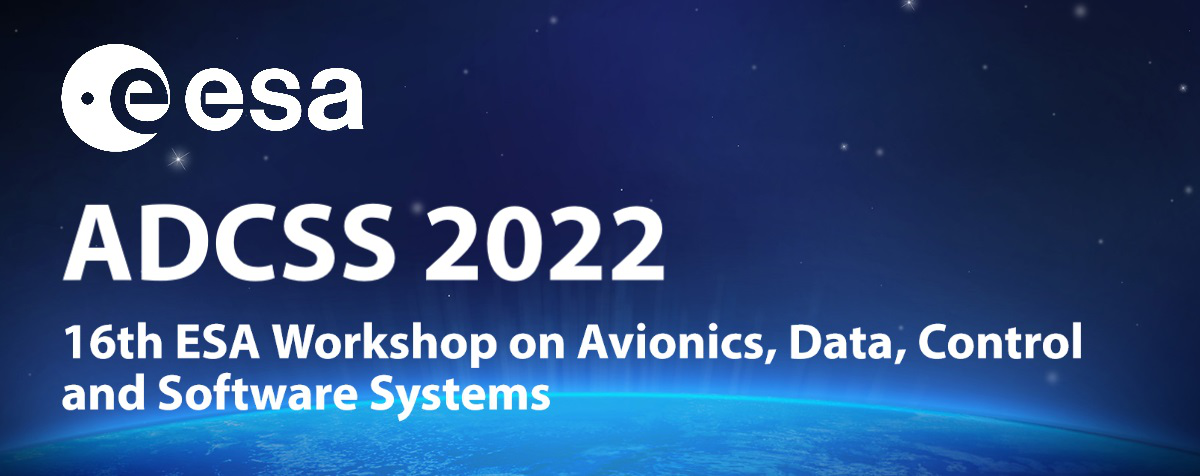Conveners
Technical Session: On-Board Processing, Co-processing and Software
- Luis Mansilla (ESA)
- David Steenari (ESA)
Technical Session: GNC – new generation Gyro, Accelerometers, Inertial Sensors
- Enrico Melone (ESA)
- Jeroen Vandersteen (ESA)
Technical Session: Processor Architecture and Software Supporting Multi-Core
- Richard Jansen (ESA)
- Christophe Honvault (ESA)
Technical Session: Functional Verification
- Bénédicte Girouart (ESA/ESTEC)
- Robert Blommestijn (ESA)
Recent advances in Earth observation, embedded computing and machine learning optimisation have led to an increasing number of demonstrations of “on-board AI”, showcasing such applications as cloud detection,ship tracking and disaster monitoring. However, there still exists a disconnect between the outputs of such applications and the real needs of end users.
In collaboration with...
New generations of spacecrafts are required to perform tasks with an increased level of autonomy. Space exploration, Earth Observation, space robotics, etc. are all growing fields in Space that require more sensors and more computational power to perform these missions. Furthermore, new sensors in the market produce better quality data at higher rates while new processors can increase...
The next generation of the Onboard Computers(OBC) targeting the “New Space Market” will involve the use of Commerical Off The Shelf (COTS) components along with Radiation Tolerant (RT) components. The COTS devices are targeted to provide high performance along with Quality of Service (QoS), high functional integration with a smaller form factor (ideally in a single chip), while the critical...
Tesat is one of the major suppliers of RF and optical downlink solutions in Europe. The key component of RF downlinksis the so-called Modulator, which encodes and modulates the downlink data onto an RF carrier either in X-band or Ka-band. Within the last 20 years, TESAT has developed various X-band and Ka-band Modulators which are flying on LEO earth observation satellites(e.g. Biomass), GEO...
The imaging sensor market for space is experiencing a rapid growth largely focused on larger area sensors and faster frame rates. This brings challenges in terms how to output a great quantity of data at high speed in a way that it is still easy to interface with the rest of the system and within a reasonable power budget. These challenges are also present in non-space commercial markets. It...
Since 2021, Airbus and iXblue have teamed up to develop the Astrix 200+, with the support of CNES. The Astrix 200+ will be the new member of the Astrix family of gyros that has demonstrated more than 6 000 000 hours of cumulated flight in-orbit without anomaly.
The development investigates the current state-of-the-art of the technology to break through the current model limitations, define...
Demand for high-performance and low SWaP (size weight and power) MEMS accelerometers able to withstand harsh environments is increasing in the space, aviation and defense market due to their inherent advantages versus legacy technologies (e.g., quartz servo accelerometers) and the proliferation of monitoring and control application requiring sensors.
Safran Sensing Technologies Switzerland...
ARIETIS-NS is a Rad-Tolerant, space qualified 3-axis gyro, whose main applications are Telecom (15+ years GEO), Earth Observation as well as Science and Exploration missions. It mostly uses commercial EEE upscreened components. ARIETIS-NS is being qualified to ESA ECSS standards, meeting the most stringent space quality requirements. ARIETIS-NS is based on Innalabs proprietary Coriolis...
Future NASA mission applications demand onboard computing performance, power efficiency, and flexibility not available from current products. To address these needs, NASA’s High Performance Spaceflight Computing (HPSC) project is developing a radiation hardened, general purpose multi-core processor. Key HPSC objectives include natural space radiation hardness, fault tolerance, computation...
Gaisler is a European vendor of radiation-hardened fault-tolerant microprocessor SoCs that develops the LEON and NOEL-V, processor models. The presentation will share Gaisler's view on applying SPARC and RISC-V in space applications. We will provide a status update on the GR740 LEON4FT quad-core SoC and the current development status of the next-generation products GR765 and GR7xV. GR765 is an...
This presentation will present all types of Microchip processing solutions from stand-alone processors to FPGA SoC developed for space applications. The targeted content will make the status of all type of products or ongoing development from the different product lines in US & in Europe on different type of processing single core or multicore architectures based on ARM or RISCV. We plan to...
The journey began with a small FPGA device called NG-MEDIUM. Then the first Rad-Hard Cortex R5 Macro is introduced in NG-LARGE. Later, the FPGA became a real-time application-oriented System-on-chip with a huge reconfigurable logic capacity (NG-ULTRA). Now it is time to go one step further and have a complex SoC with Cortex A and Cortex R processors. Thanks to the DUROC project, Nanoxplore has...
TASinI adopted MultiCore Processor in their On Board Computer since the first announced development of ESA NGMP in 2011 up to the release of first prototype of Quad-Core Leon4FT GR740 SoC in 2015. In this 11 years the IPAC, Integrated Processor and Aocs Controller, On Board Computer family has been developed covering a wide range of space applications; the development covered both Hardware and...
This session aims to give European Spacecraft LSIs the stage to present their current process, lessons learnt and perspectives on Avionics Functional Verification. Product line specifics wrt Avionics Functional Verification are interesting to address, in view of current and future ESA missions. The recently published ECSS-E-ST-10-03C Rev.1 "Testing" and ECSS-E-HB-10-03A "Testing guidelines"...
This session aims to share ESA lessons learnt on Avionics Functional Verification for SmallSat and Nanosat platforms, in relation to the ESA mission classification. ESA will present guidelines for the development of nanosat AOCS systems elaborated from the technical experience gained on the numerous nanosat missions supported by the Agency, from Education missions to IOD/IOV and operational...
This session aims to present and share with ADCSS audience the activities initiated to prepare for defining reliable verification process of AI-based flight software and AOCS/GNC systems. Related activities are planned for the next couple of years, in particular through the ESA GSTP Compendium on Artificial Intelligence. This preliminary announcement of future and intended activities will...

